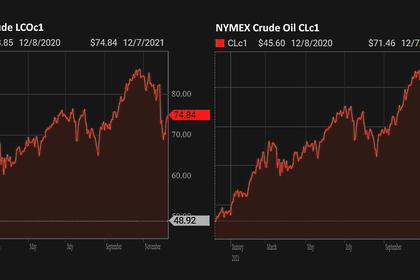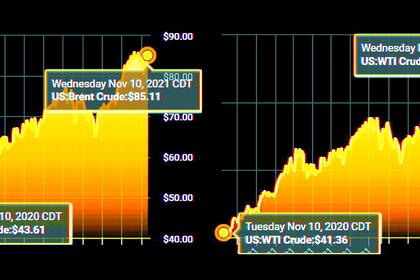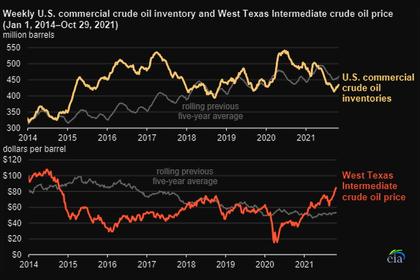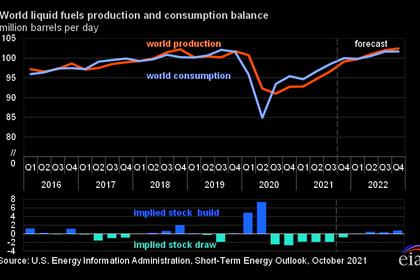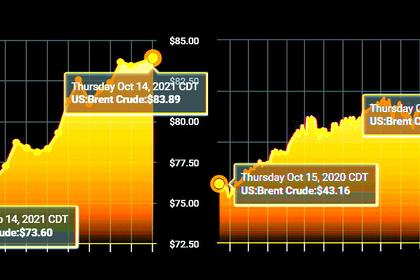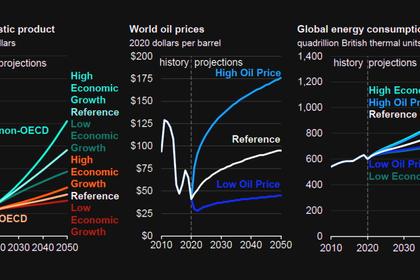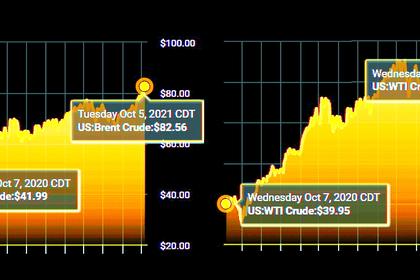
OIL PRICES 2021-22: $71-$70
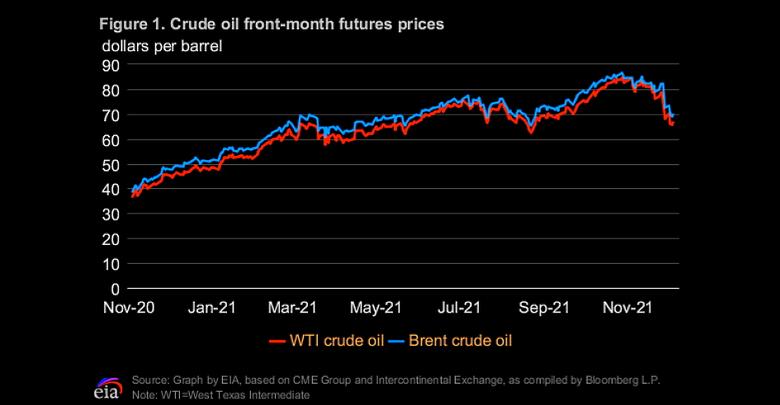
U.S. EIA - Dec. 7, 2021 - Short-Term Energy Outlook
Forecast highlights
Global liquid fuels
• The December Short-Term Energy Outlook (STEO) remains subject to heightened levels of uncertainty related to the ongoing recovery from the COVID-19 pandemic. Notably, the emergence of the SARS-CoV-2 Omicron variant raises uncertainty about the level of energy consumption throughout the world compared with last month’s forecast. U.S. gross domestic product (GDP) declined by 3.4% in 2020 from 2019 levels. This STEO assumes U.S. GDP will grow by 5.5% in 2021 and by 4.4% in 2022. The U.S. macroeconomic assumptions in this outlook are based on forecasts by IHS Markit. The U.S. macroeconomic forecast and the global macroeconomic forecast from Oxford Economics were completed in mid-November before the Omicron variant was identified. In addition to uncertainty about macroeconomic conditions, winter weather along with the evolving effects of consumer behavior on energy demand because of the pandemic present a wide range of potential outcomes for energy consumption. Supply uncertainty in the forecast results from the production decisions of OPEC+ and with the rate at which U.S. oil and natural gas producers increase drilling.
• Brent crude oil spot prices averaged $81 per barrel (b) in November, a $3/b decrease from October 2021 but a $38/b increase from November 2020. Crude oil prices have risen over the past year as result of steady draws on global oil inventories, which averaged 1.4 million barrels per day (b/d) during the first three quarters of 2021. Crude oil prices fell significantly on November 26, and the Brent spot price began December below $70/b. The drop in prices followed the identification of the new COVID-19 Omicron variant, which raised the possibility that petroleum demand could decline in the near term.
• We expect Brent prices will average $71/b in December and $73/b in the first quarter of 2022 (1Q22). For 2022 as a whole, we expect that growth in production from OPEC+, of U.S. tight oil, and from other non-OPEC countries will outpace slowing growth in global oil consumption, especially in light of renewed concerns about COVID-19 variants. We expect Brent prices will remain near current levels in 2022, averaging $70/b.
• We estimate that 99.7 million b/d of petroleum and liquid fuels was consumed globally in November, a 4.9 million b/d increase from November 2020 but 1.1 million b/d less than in November 2019. We revised down our forecast of consumption of petroleum and liquid fuels for 4Q21 and 1Q22, partly as a result of recently announced travel restrictions following reported outbreaks of the Omicron variant of COVID-19. The potential effects of the spread of this variant are uncertain, which introduces downside risks to the global oil consumption forecast, particularly for jet fuel. We forecast that global consumption of petroleum and liquid fuels will average 96.9 million b/d for all of 2021, which is a 5.1 million b/d increase from 2020. We forecast that global consumption of petroleum and liquid fuels will increase by 3.5 million b/d in 2022 to average 100.5 million b/d.
• U.S. regular gasoline retail prices averaged $3.39 per gallon (gal) in November, a 10 cents/gal increase from October and $1.29/gal higher than in November 2020. The November monthly average was the highest since September 2014. We forecast that retail gasoline prices will average $3.13/gal in December before falling to $3.01/gal in January and $2.88/gal on average in 2022.
• Total U.S. crude oil production was an estimated 11.7 million b/d in November. We forecast that it will rise to an average of 11.8 million b/d in 2022 and to an average of 12.1 million b/d in 4Q22.
Natural Gas
• In November, the natural gas spot price at Henry Hub averaged $5.05 per million British thermal units (MMBtu), down from the October average of $5.51/MMBtu but up from an average of $3.25/MMBtu in the first half of 2021 (1H21). After rising in recent months, natural gas prices declined in November amid mild weather across much of the country that resulted in less natural gas used for space heating than expected. Decreased demand for natural gas also contributed to inventory levels moving closer to the five-year (2016–20) average. Global demand for U.S. liquefied natural gas (LNG) has remained high, limiting some downward pressure on natural gas prices.
• The Henry Hub spot price averages $4.58/MMBtu from December 2021 through February 2022 in our forecast and then generally declines through 2022, averaging $3.98/MMBtu in 2022 amid rising U.S. natural gas production and slowing growth in LNG exports. We forecast that U.S. inventory draws will be similar to the five-year average this winter, and we expect that factor, along with rising U.S. natural gas exports and relatively flat production through March, will keep U.S. natural gas prices near recent levels before downward price pressures emerge. Because of uncertainty around seasonal demand, we expect natural gas prices to remain volatile over the coming months, and winter temperatures will be a key driver of natural gas consumption and prices.
• We estimate that U.S. LNG exports averaged 10.7 billion cubic feet per day (Bcf/d) in November 2021, a 0.8 Bcf/d increase from October, supported by large price differences between the Henry Hub price in the United States and spot prices in Europe and Asia. LNG exports resumed from Cove Point LNG in late October after that facility’s annual maintenance was completed. In our forecast, LNG exports average 9.8 Bcf/d for all of 2021, a 50% increase from 2020. We expect that LNG exports will average 11.1 Bcf/d from December through March. We expect high levels of LNG exports to continue into 2022, averaging 11.5 Bcf/d for the year, a 17% increase from 2021. The forecast reflects our assumption that global natural gas demand remains high and U.S. LNG export capacity increases.
• U.S. natural gas inventories ended November 2021 at more than 3.5 trillion cubic feet (Tcf), 3% less than the five-year average for this time of year. Less natural gas was injected into storage this summer than the previous five-year average, largely as a result of more electricity consumption in June because of hot weather, and because of increased exports. However, storage levels moved closer to average as injections outpaced the five-year average in September, October, and early November. We expect natural gas inventories to fall by 2.0 Tcf during the November-to-March withdrawal season, ending March below 1.7 Tcf, which would be 2% less than the 2017–21 average for that time of year.
• We estimate dry U.S. natural gas production averaged 96.1 Bcf/d in the United States in November, up 1.0 Bcf/d from the average in October. Production in November was up from an average of 91.9 Bcf/d in 1H21. Natural gas production in the forecast rises to an average of 95.3 Bcf/d during the rest of this winter (December–March) and averages 96.0 Bcf/d for all of 2022, driven by natural gas and crude oil price levels that we expect will be sufficient to support enough drilling to sustain production growth.
Electricity, coal, renewables, and emissions
• We forecast that the share of electricity generation produced by natural gas in the United States will average 37% in 2021 and 35% in 2022, down from 39% in 2020. For 2021, the annual share for natural gas as a generation fuel declines in response to our expectation of a higher delivered natural gas price for electricity generators, which we forecast will average $4.99/MMBtu compared with $2.40/MMBtu in 2020. The natural gas share declines in 2022 as a result of continued high fuel costs and an increasing share of renewable generation. As a result of the higher expected natural gas prices, the annual forecast share of electricity generation from coal rises from 20% in 2020 to 23% in 2021 and then drops slightly to 22% in 2022. For renewable energy sources, new additions of solar and wind generating capacity have been offset somewhat by reduced generation from hydropower this year. As a result, we forecast that the share of all renewables in U.S. electricity generation will average 20% in 2021, about the same as last year, before rising to 22% in 2022. The nuclear share of U.S. electricity generation declines from 21% in 2020 to 20% in 2021 and 2022.
• We expect coal production to rise by 48 million short tons (MMst), or 9%, in 2021 and by an additional 38 MMst (6%) in 2022. The increase in production reflects more demand and higher prices for coal in the electric power sector because of higher natural gas prices this year compared with last year. Despite the increase in production, growth has not kept pace with rising domestic demand for steam coal in the electric power sector and export growth. As a result, coal inventories held by the electric power sector fall by an expected 51 MMst (38%) in 2021 and a further 10 MMst (13%) in 2022.
• Planned additions to U.S. wind and solar capacity in 2021 and 2022 increase electricity generation from those sources in our forecast. We estimate that the U.S. electric power sector added 14.6 gigawatts (GW) of new wind capacity in 2020. We expect 17.2 GW of new wind capacity will come online in 2021 and 7.1 GW in 2022. Utility-scale solar capacity rose by an estimated 10.4 GW in 2020. Our forecast for added utility-scale solar capacity is 16.2 GW for 2021 and 20.9 GW for 2022. We expect significant solar capacity additions in Texas during the forecast period. In addition, in 2020, small-scale solar capacity (systems less than 1 megawatt) increased by 4.4 GW to 27.6 GW. In particular, Texas and Florida had large increases of small-scale solar capacity in 2020. We project that small-scale solar capacity will grow by 5.1 GW in 2021 and by 5.0 GW in 2022.
• U.S. energy-related carbon dioxide (CO2) emissions decreased by 11% in 2020 as a result of less energy consumption due to reduced economic activity and to end user responses to the COVID-19 pandemic. For 2021, we forecast energy-related CO2 emissions will increase about 7% from 2020 as economic activity increases and leads to rising energy use. We expect a 1% increase in energy-related CO2 emissions in 2022. We forecast that after declining by 19% in 2020, coal-related CO2 emissions will rise by 17% in 2021 and then fall by 3% in 2022.
-----
Earlier:
